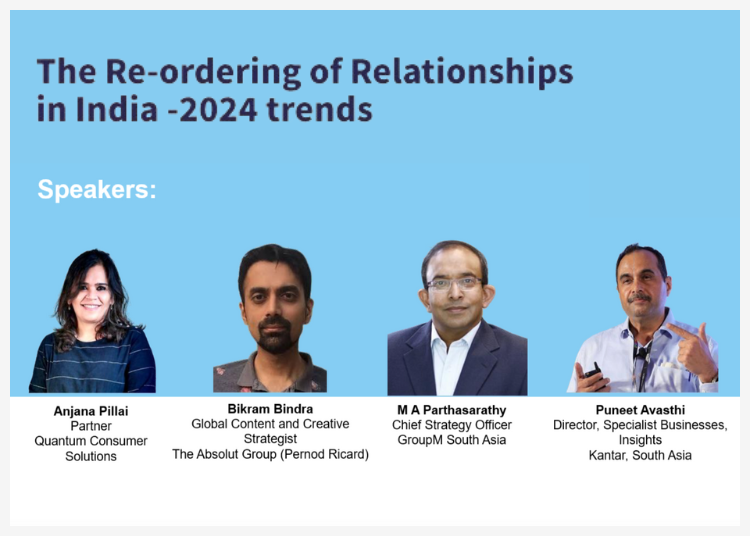The Market Research Society of India (MRSI) conducted a webinar on the ‘The Re-Ordering Of Relationships In India – 2024 Trends’, featuring a panel of industry professionals ranging from Puneet Avasthi, Director, Specialist Businesses, Insights at Kantar; Parthasarathy MA also known as Maps, Chief Strategy Officer at GroupM; Bikram Bindra, Global Content and Creative Strategist at The Absolut Group (Pernod Ricard); Anjana Pillai, Partner at Quantum Consumer Solutions.
The session was moderated by Mukul Gautam, Vice President & Chief of Capacity Building at Purple Audacity.
During the webinar, the panellists presented a slide deck that highlighted how relationship dynamics are changing and brands are evolving with them in terms of India’s wealth pyramid, the rise of Connected TV, the onset of brands rejecting societal labels and showcasing fluidity and diversity in relationships and a cultural lens to the re-ordering of relationships.
Exploring relationships across India’s diverse wealth spectrum, Kantar’s Avasthi examined the dimensions of relationships as a lens of the wealth pyramid of India because it is a very diverse country and there are fairly large populations living in contrasting circumstances.
“We looked at the claimed monthly household income of different individuals as part of our TGI study, and we put together a pyramid where we saw that while the top 5% of India’s population contributes to 14% of monthly household expenditure, the bottom 20% of the population which resides in traditionally economically backward areas of states like Uttar Pradesh, Bihar, India, Karnataka, Odisha, Madhya Pradesh and Chhattisgarh, contributes to only 10% of the total monthly expenses,” he said.

Furthermore, he also emphasised the kind of contribution that the country’s population has to monthly expenditure is not sufficient making it all the more important to understand what defines these people and what are the values that are over-indexed by these income class segments.
As for GroupM’s Maps who led the discussion on ‘Evolution of Common Currencies of Conversation’ focused on the shifts from the lens of content consumption and families and the subsequent impact on areas such as category, brand perception, behaviours and more.
According to him, one of the strongest binding forces of any relationship or community is the ability to have common topics of conversation and there have been several shifts in the recent past that have opened up new opportunities as common currencies of conversation among the members of a family or community.
The fastest-growing media in India today is Connected TV or Addressable TV, which is slated to grow to about 45 million households by the end of 2024 to include 20% of all TV households in India.
Firstly, over 90% of all TVs sold in the country today are smart TVs. Secondly, internet penetration has crossed 50%, and the cost of data is among the cheapest in the world. Thirdly, there is a plethora of content that people want to view, and they are concerned about missing out. Putting all of this together creates an exponentially growing medium.
Addressable TV combines live television for sports such as the Indian Premier League with on-demand streaming. Looking back at the previous generation, the mobile screen caused individuals to grow apart, driving individual consumption to the force. However, Connected or Addressable TV is reviving the phenomenon of co-viewership, which means that it brings families together to watch common content, thereby creating common currencies of conversation.
While talking about a survey conducted at GroupM of over 4,000 consumers in 2023 on TV viewing habits, Maps stated that the co-viewership in households where they watched Addressable TV was higher than in households which watched only linear TV or traditional television.

The highest gap was for viewership with partners. This might be interpreted as more conversation and collaborative decision-making about the content viewed nowadays in households.
“We have also noticed from personal experiences that different family members might suggest what should be viewed together, exposing them to different types of content based on what individual members of the family are familiar with. As a result, common conversation currencies have increased,” said Maps.
As per Maps, there is a rising influence of Generation Alpha (Gen Alpha), the generation born after 2010. This is the largest segment of Volume in India and it is around 20-25% of the overall population. The oldest of these Gen-Alphas are slated to be the most educated and informed generation of all.
The knowledge, exposure and perspective of Gen Alpha have resulted in them having a strong influence on category and brand decisions within a household, even in categories where they are not the primary consumers.
Presenting his views on the “Reflections and manifestations of changes in pop culture”, the Absolut Group’s Bindra stated that popular culture and content media are trying to question the stereotypical approach of a family unit that we have been exposed to.
However, brands and businesses are trying to move away from that by showcasing diversity in the way families are being represented. They are recognising that families could come in different shapes and sizes and look outside of the house of heteronormativity and thereby rejecting societal labels and showcasing fluidity and diversity in relationships.

One of the first few brands that did this was McCain with a campaign titled ‘Be Our Family’ which talked about family is how you choose to define it. Hence, providing a refreshing discourse in terms of relationship representation.
Similarly, in P&G Vicks’ ‘Touch of Care’ campaign, they took Gauri Sawant, who is a transgender activist based in Mumbai. They took her example and how there was a family unit of her with a child that she decided to adopt.
Brands are moving out of the classic construct of how families are and moving onto the strong evolving relationship dynamics that culture media advertising is reflecting.
According to Bindra, as per patriarchal norms, it is always the mother who imparts education to the daughter, and the need for identity formation and standing up and demonstrating a certain strength, whether mental, physical, or emotional, cuts across classes and representations.
Brands such as Hindustan Unilever’s Clinic Plus and Rin discuss the strength of a mother-daughter bond that focuses on empowering each other. Linked to this is the idea of children actively acting as change agents, giving a new viewpoint to interpersonal dynamics and families.
“There is a rise in feminism which results in the rise in sisterhood and solidarity amongst women. There are various examples of this in terms of content, films, shows and advertisements that spread the message of ‘I’ve got your back and we will rise together’ as opposed to the classical tropes which would pit women against each other,” said Bindra.
“As a counter to this, we have also seen a sort of rise in the relationship between men and the return of the alpha male. Movies like Animal strongly reflect that,” he added.
There was another campaign, titled ‘Be an Absolut Ally’ which was a recognition of one’s identity, a celebration of who they are and an unboxing of what is expected from one.
Taking cue from this, Quantum Consumer Solutions’ Pillai shared insights into ‘Digging Deeper Into What’s Changing On The Relationship Scene- The Cultural Shifts That Are Driving These Changes’ and explained how a relationship between any two people is actually between two constructed images and rules.
“There are multiple discourses today, globally, locally, at a national level, the politics, economics of it and more that are colliding with these cultural forms and when you expose yourself to all these different discourses as a result of the exposure, what happens is that as an individual you feel the need to craft yourself newly concerning these new influences,” she said.
She further explained that the responses could be either that one rejects these new influences and goes back to solidifying their current identity or accepts the new discourse. Therefore, altering their responses, perception of self and the way they look at others as well. Hence, in both these cases, how one responds to these discourses impacts the entire spectrum of their relationship with the others.
During her presentation, Pillai delved into various discourses. The first discourse was ‘Feminism’ which comprised topics such as how women’s relationships with themselves are changing, how male anxiety has been peaking and many rifts and tears in the fabric of a couple’s relationship.

The second discourse was ‘Digitised relationships’, the third discourse was ‘Nuclearisation’, the fourth discourse was ‘Individualisation and its impact on relationships’ and the fifth discourse was ‘Spiritualism and Mindfulness’.













